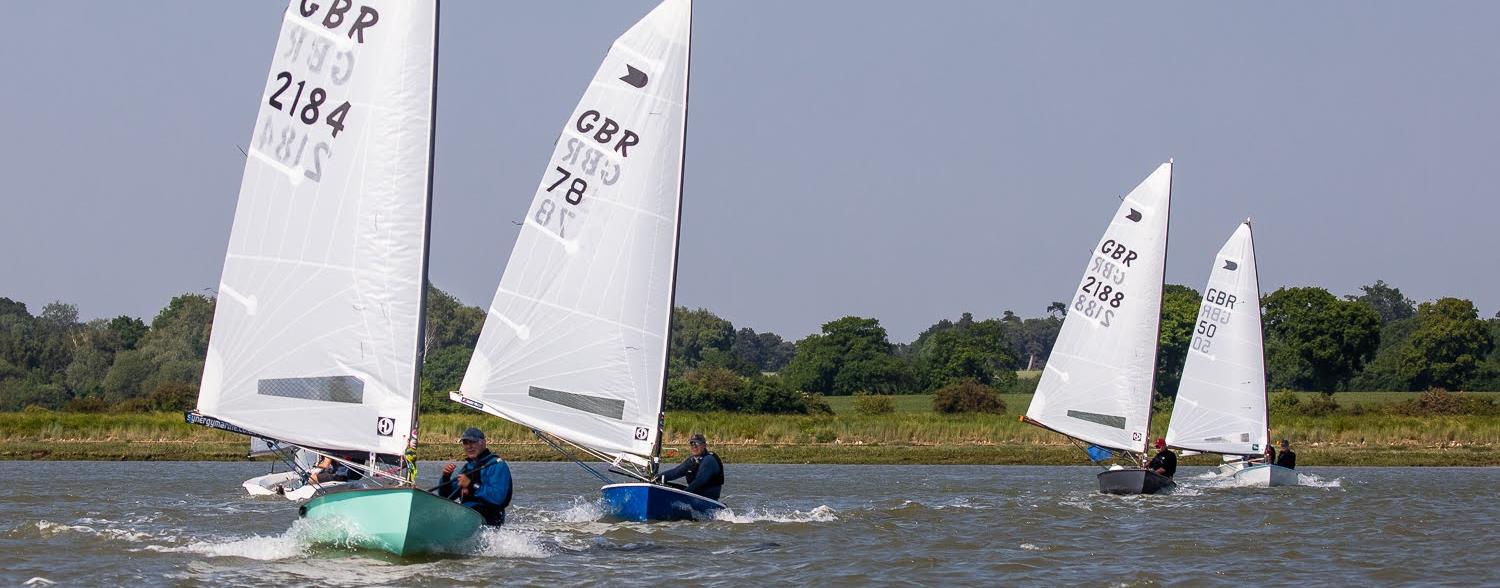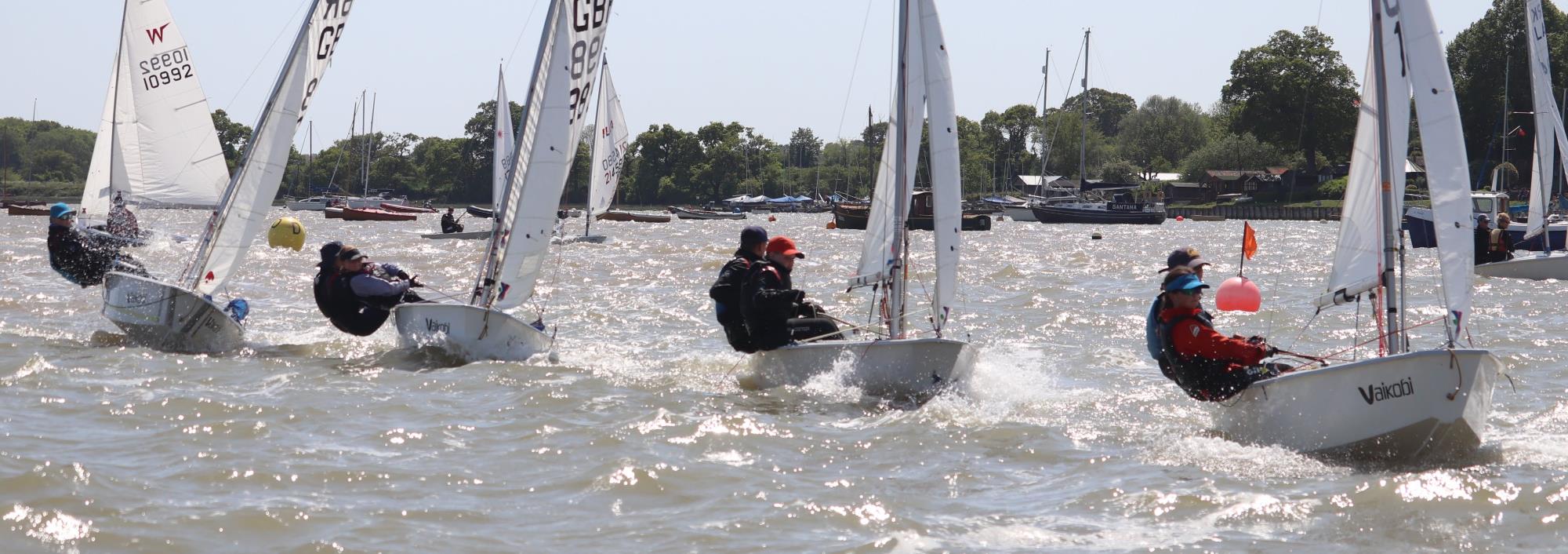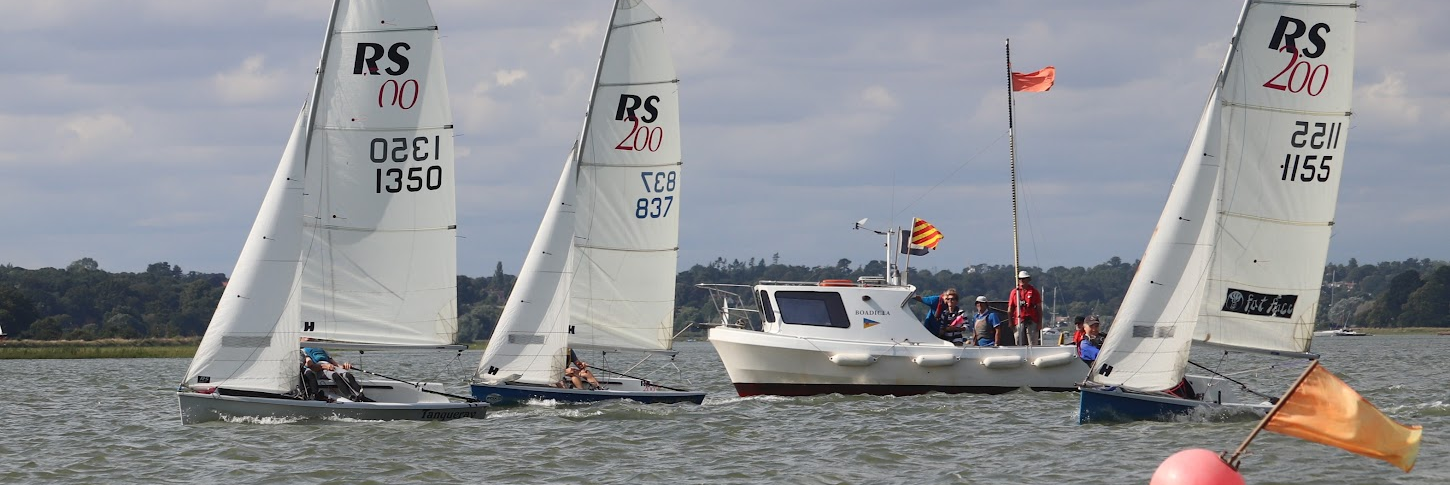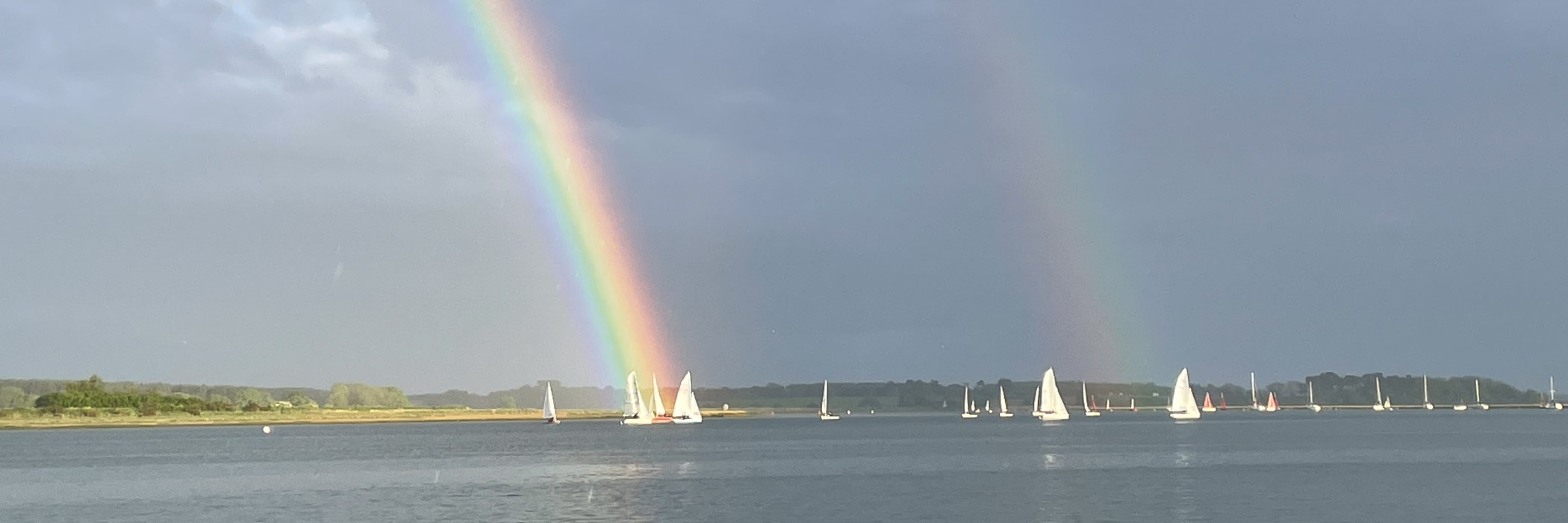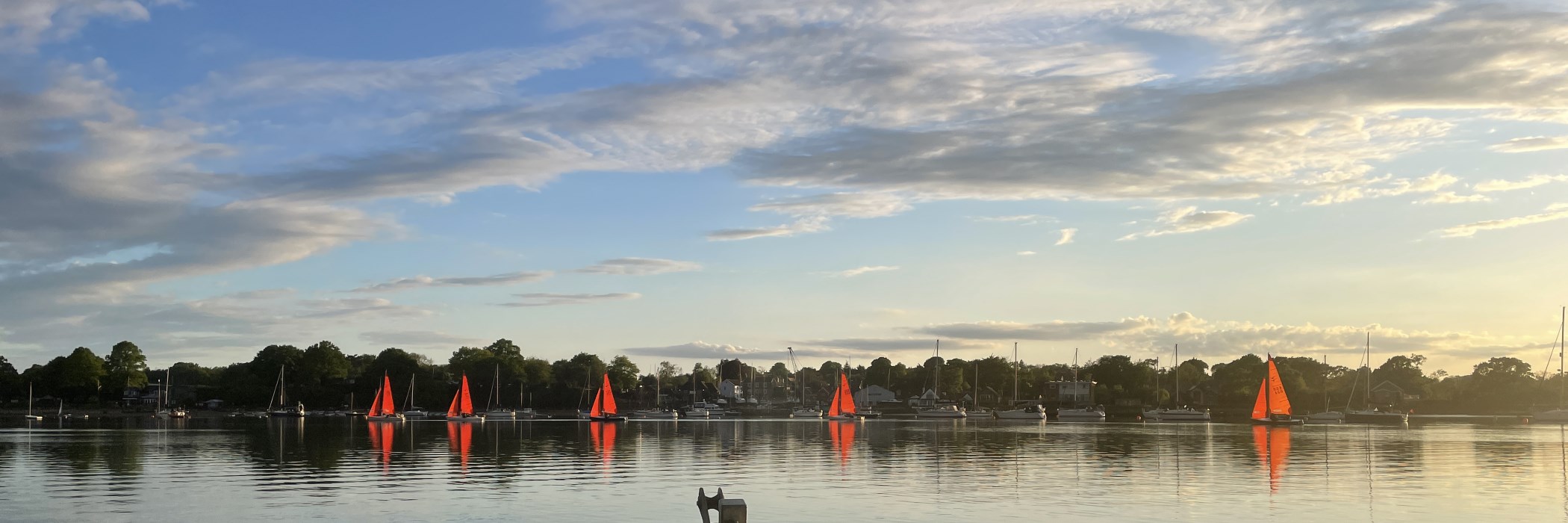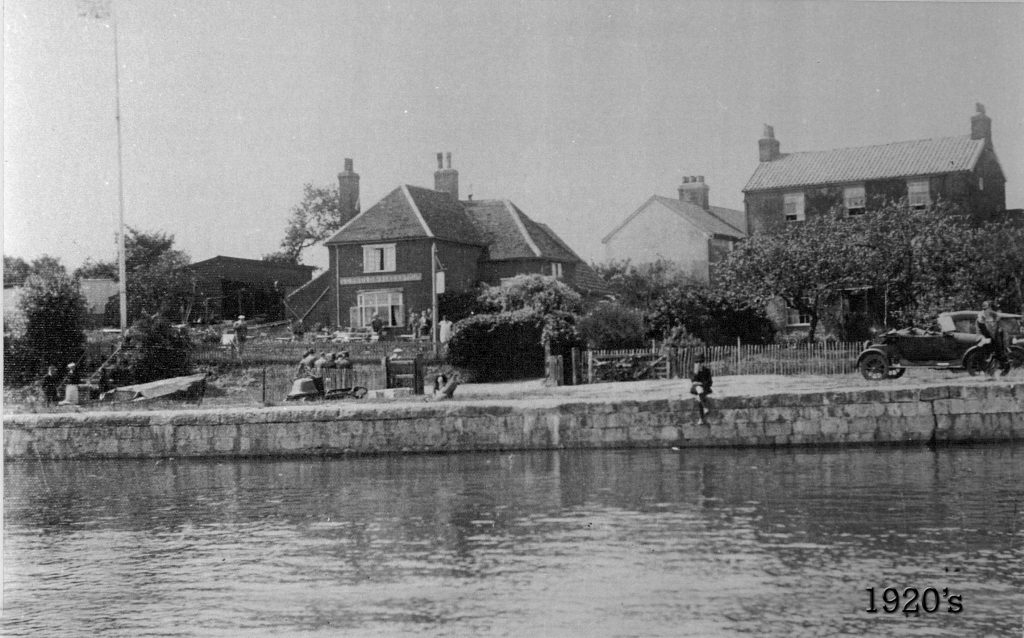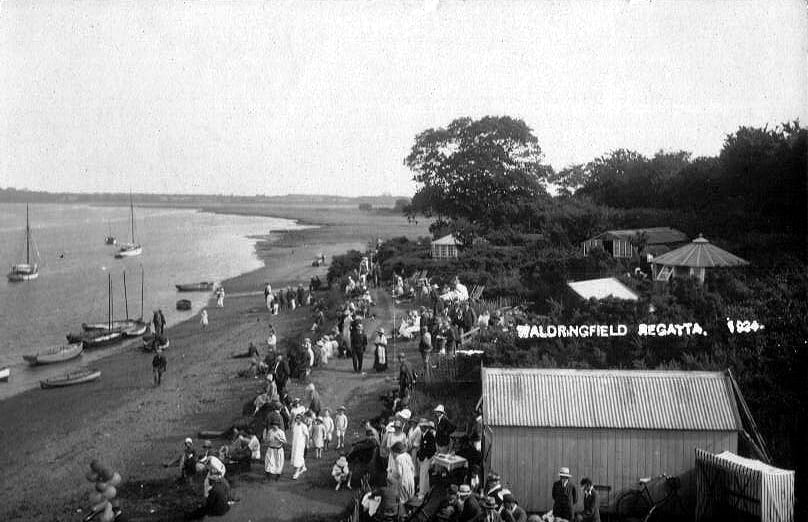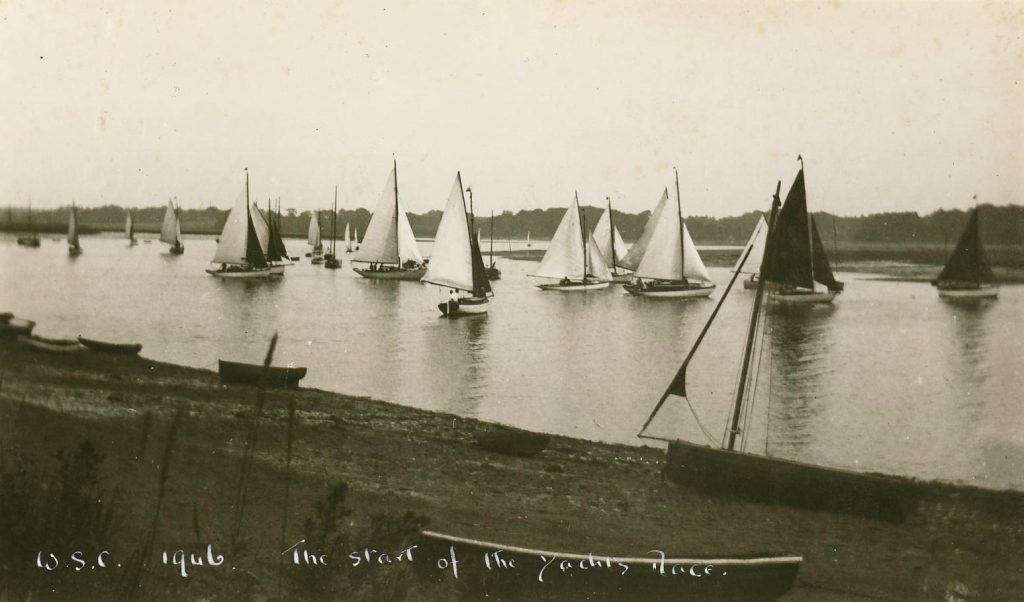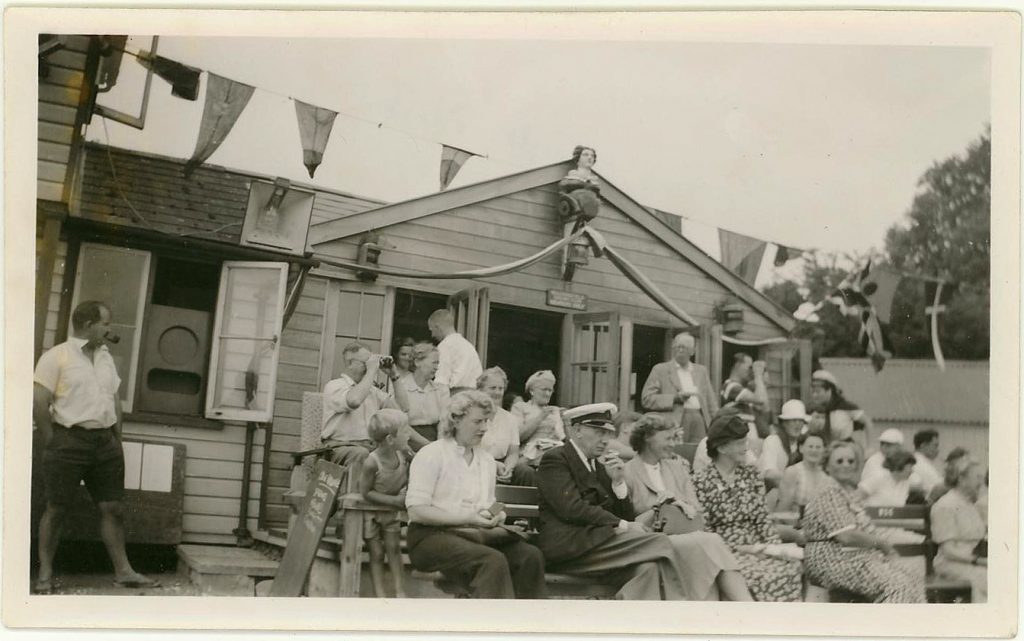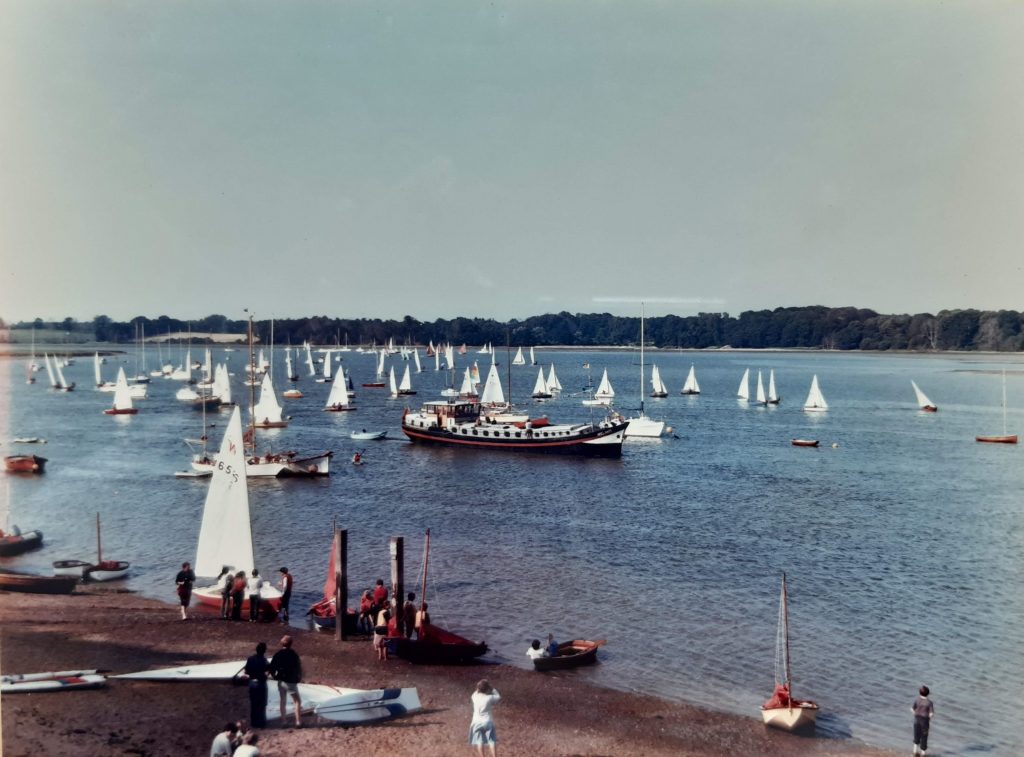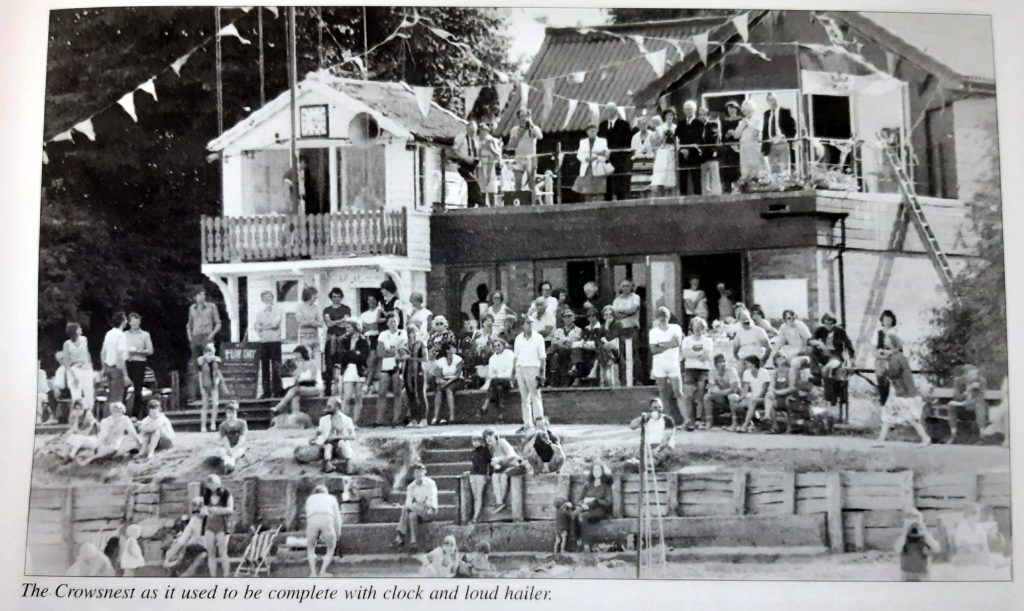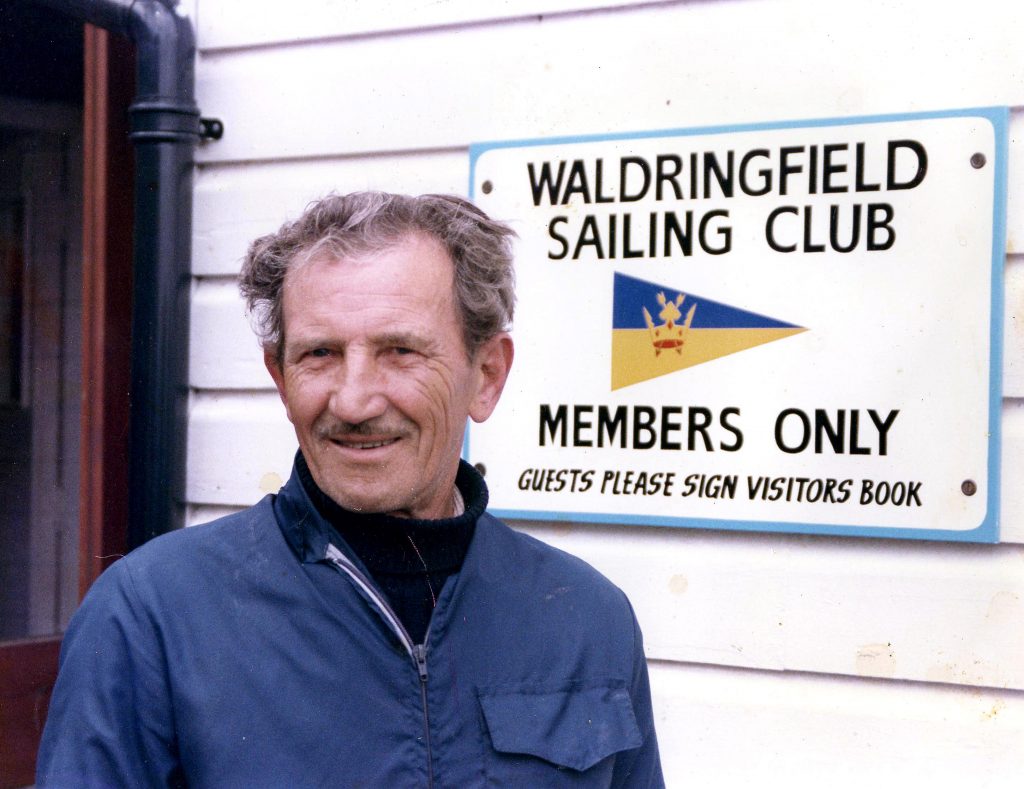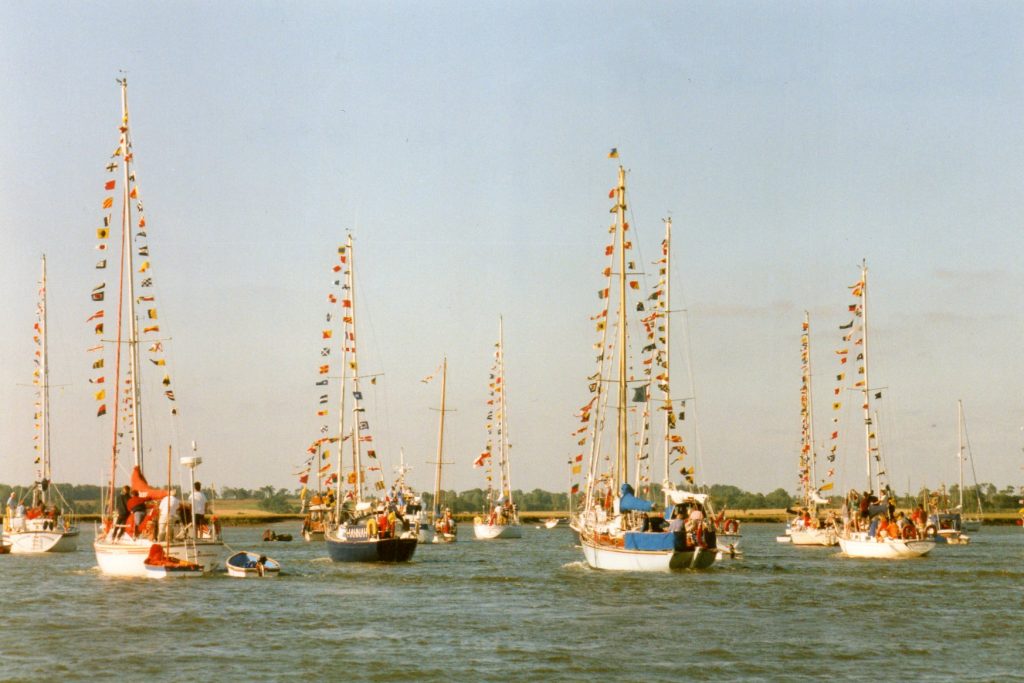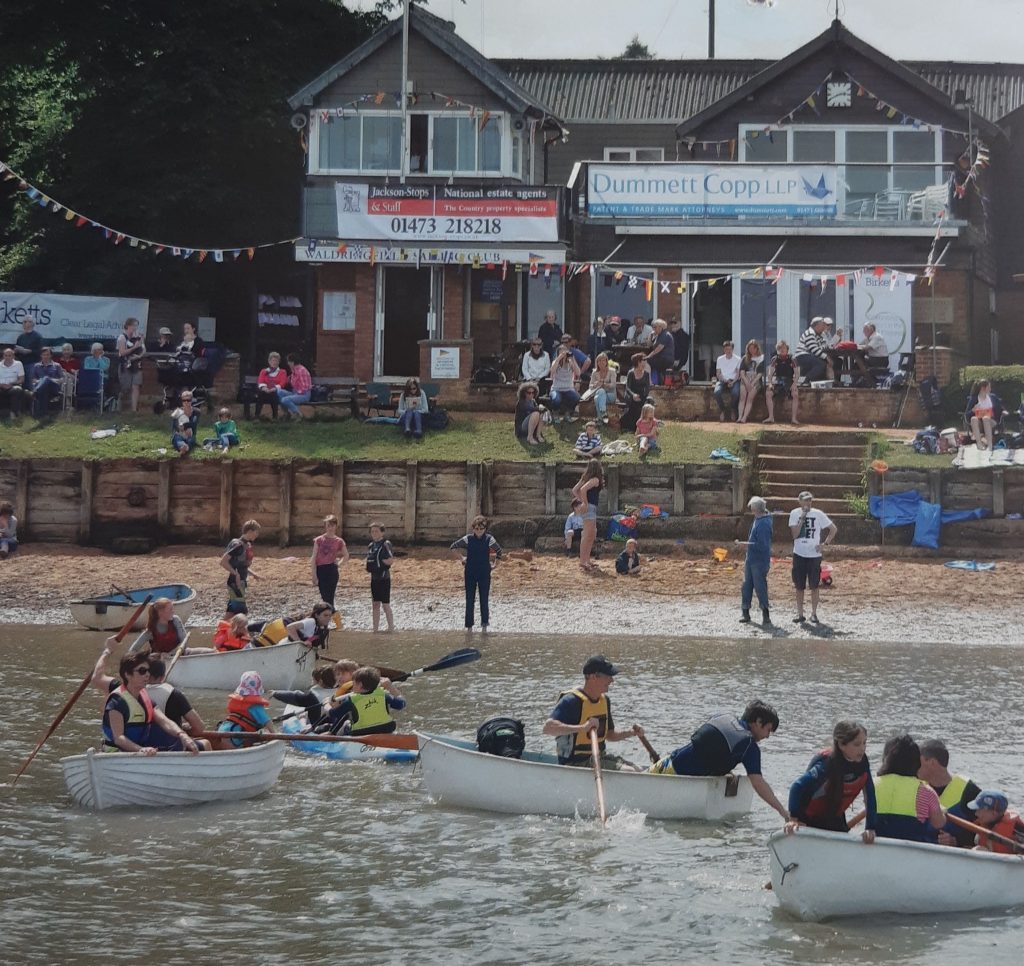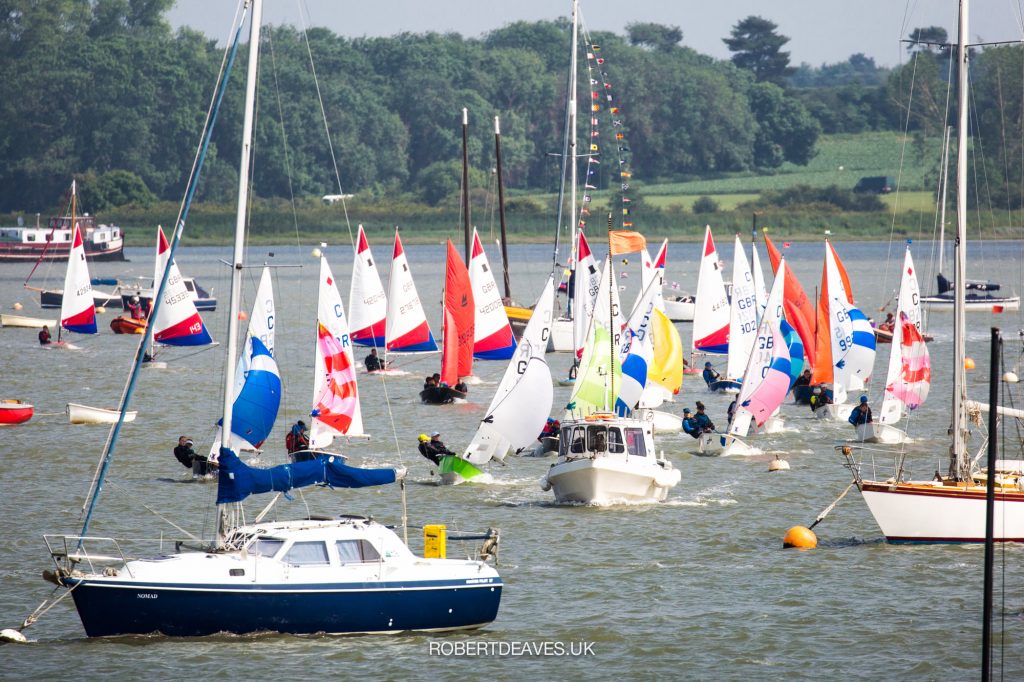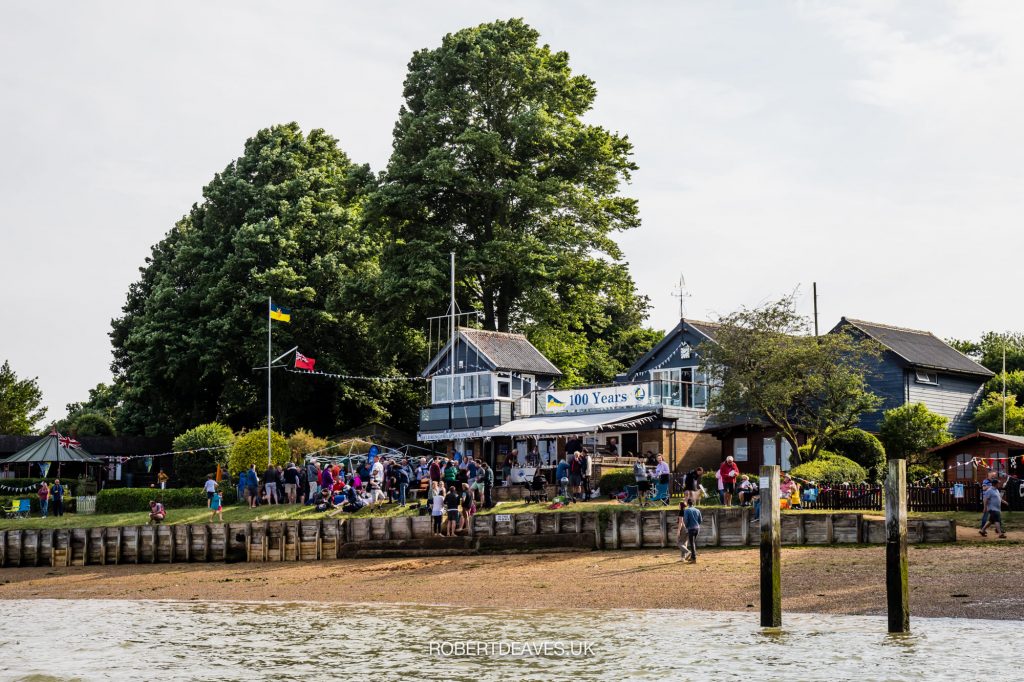The River Deben at Waldringfield was always an important stop for working boats, Barges, Billyboys, Snows, Ketches and Schooners. Barges bound for Waldringfield were usually loaded with manure for the farmers, coal for the local market, clay for the cement works, or waiting on a safe anchorage for pilots to take them up to Woodbridge.
Towards the end of the 19th Century the Cement works at Waldringfield would have been the main destination for many of the Barges but in 1907 the Cement Works closed down and Yachts began to take the place of the Barges. Some barge crew came ashore to work but still kept their links to the river and sailing, gradually allowing more time for leisure. Annual Summer Regattas at Waldringfield from around this time became popular as the area became less industrial.
Racing and leisure sailing had long been established on the Deben from Woodbridge, with races up and down river from the 1860s. Many of these paid crew members came from Waldringfield.
In the Spring of 1921 the first minute book of the Sailing Club records the meeting at Gorse Cabin to form a Sailing Club for the Village. Sir Clifford Paterson (a regular visitor from London and married to Daisy Ogden), Mr Harry Nunn (Boatyard) and Mr T.N.Waller (Villager) were President, Secretary and Treasurer respectively with Mr A.W.Stollery (Born Waldringfield) as Chair. A. Quantrill, R. Button Jnr & C. Rix (all Villagers) formed the rest of the Committee and so the Waldringfield and Hemley Sailing Club was born, ‘club sailings to be every fortnight + holidays, Tide and weather permitting’. Waldringfield Regattas were sailed each summer.
The regular boats sailed at the club in the following year included a gig ‘Try Me’ (which had belonged to the racing Yacht ‘Brynhild’ – built for Sir James Pender in 1907. It dramatically sank in 1910. ) sailed by ex-barge skipper Arthur Quantrill; a 14’ half-decked yacht called ‘Wild Rose’; ‘Ruth’ a 14’ Barge dinghy sailed by Trevor Waller; ‘Lizzie’ a 14’ rowing boat previously owned by the Ogden family (until replaced with yacht ‘Clytie’) which was later given a keel and sails by Tom Waller and ‘Me Too’ an 18′ a smaller edition of the more famous Cherub class. Arthur Quantrill won the first season’s racing and was awarded the cup.
The membership in 1924 numbered 19 and by 1930 had only risen to 30. In 1928 the Officers of the Club were altered to include 3 vice presidents and 2 secretaries and a racing committee comprising of T. Waller, C. Rix & E.A. Nunn. A donation list for the proposed regatta raised £26.16 6d which was a tidy sum in those days. By 1929 it was decided that the title of President be dropped and Sir Clifford Paterson was elected Commodore with a corresponding reduction in the number of vice presidents.
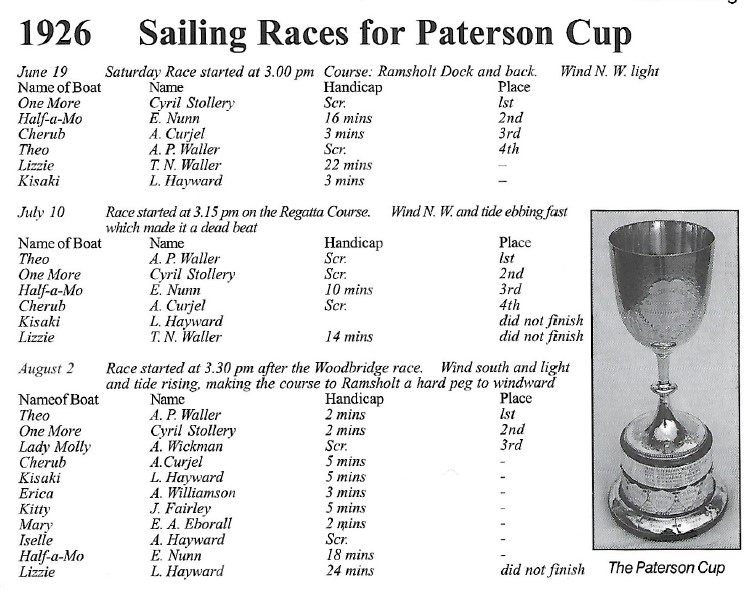
By 1931 Mr A W Stollery felt that Gorse Cabin was becoming too small for meetings and that it was suggested that it was time to consider building a proper Club House. Canon A.P. Waller suggested a site for the building near to the Gorse Cabin on a previous ‘coprolite working’ and fund raising began. In 1932 the new Club house was opened.
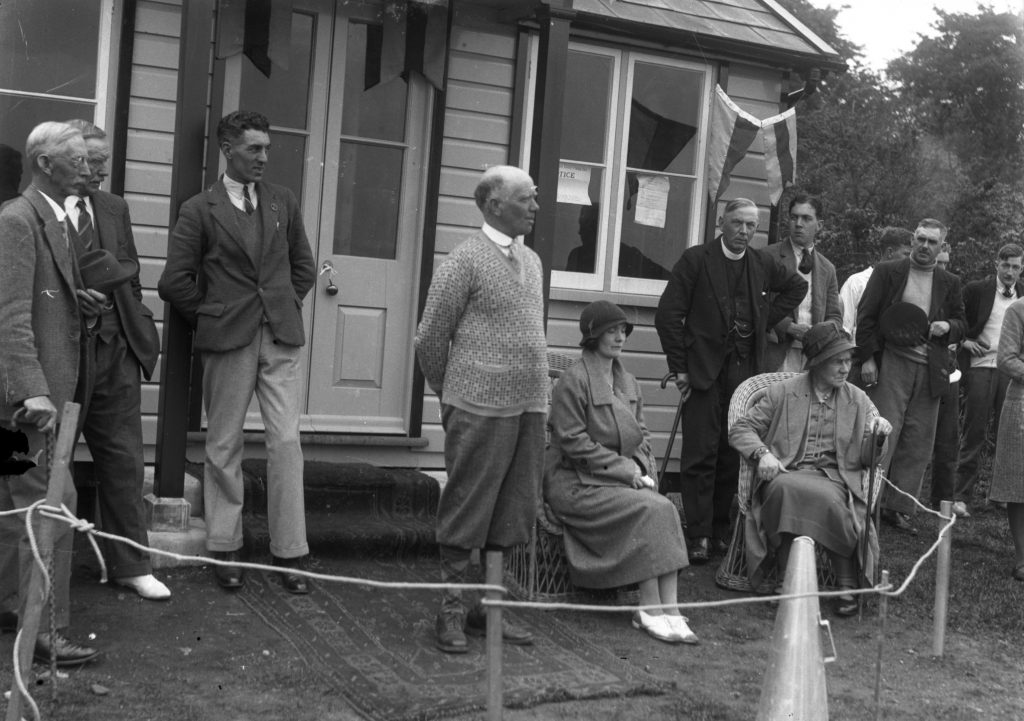
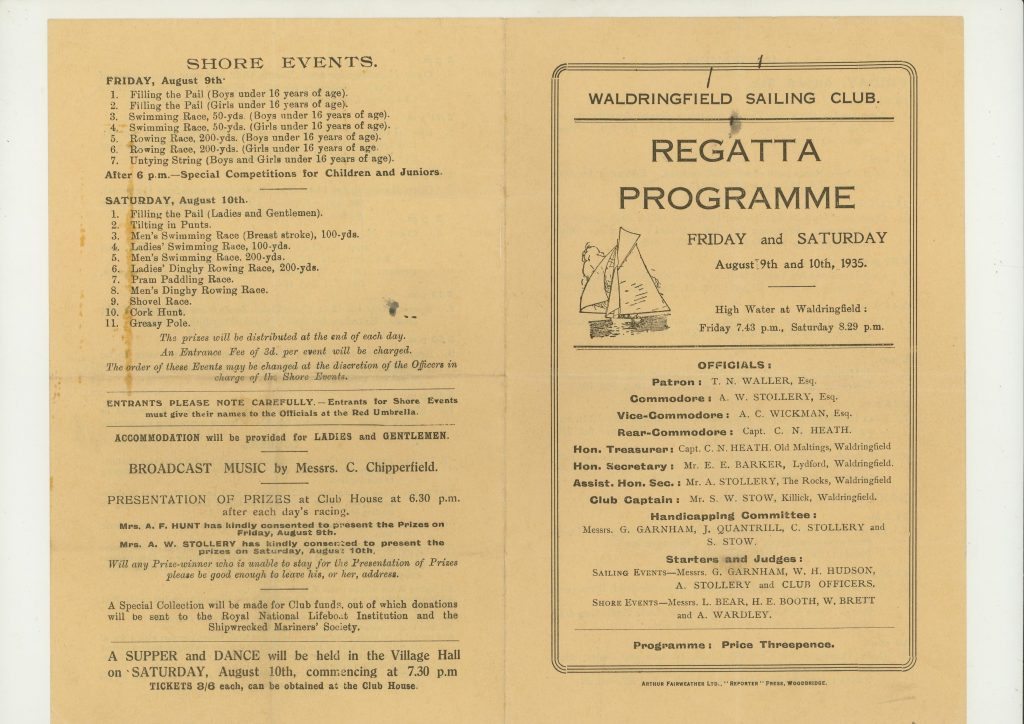
The various sailing races had entry fees of around 2/6 and prize money and were around set courses starting on the clubline, either north or south depending on the wind direction.
By 1933 the name was changed to Waldringfield Sailing Club, dropping the ‘Hemley’ name and Subscriptions were raised to 5/- . Originally membership was restricted to villagers but this was later changed to include neighbouring villages and those with links to the village e.g. summer visitors (although they had no right to vote in regard to the management of the Club). Even then Waldringfield was becoming a popular destination for holidaying Londoners and second home owners.
The 1936 regatta was significant because it was the very first instance of National 12s racing at Waldringfield, along with the earlier international 12-foot dinghy class and other non-class dinghies. Cyril Stollery and Ken Palmer had connections to several of them including N153 ‘Itch’ built by Nunn brothers. Together that year they also won the first Burton Cup outright at the Burton Week Championships. The following year Sir William Burton presented the present cup which remains the premier challenge trophy in the Class.
By 1937 membership stood at 100.
Of course the river & beach was put out of bounds during the war years 1939-1945 but by April 1946 members were keen to get the Club back running again. The Flag Officers presented the Victory Plate to be raced for on Whit Monday and this trophy is still raced for annually. In 1947 the sailing committee was formed under Dr K.W.N. Palmer. Interclub racing between WSC, FFSC, and DYC, took place and Mrs Nunn at the Ramsholt Arms prepared the afternoon teas.
In 1948 an army hut was bought for the club house extension at a cost of £90 and club members joined together digging foundations, moving earth, putting up electricity poles, digging a well, cesspit and a soakaway. In 1949 the extension was opened with a very successful Sherry Party and Dance in celebration. Despite rationing the Galley provided tea and sandwiches. In the same year The Junior section was started and 2 Cadet Dinghies were presented by Eric Wilde to the Ipswich School Sailing Club for the use of junior members and the launch of 16 Dragonflies was also a highlight of the year.
The early 1950s saw the start of the National 12 and the Firefly fleet racing at WSC. 2 Changing rooms were added to the clubhouse in 1952 and the Easter Egg trophy for 12’ Class boats was held on Easter Monday and serious Wednesday evening points racing started in 1953. Canon Waller also gave permission for a smaller dinghy park to be established on its present site. It was very muddy so second hand timber was purchased to build a surround and earth from behind the club and George Turner’s nearby hut was used as infill. In 1955 the club purchased its first rescue boat, a second hand boat brought round from New Cut, Ipswich and greeted with the firing of a gun on its arrival. Ted Kaznica agreed to man it for rescue work. The Waldringfield Cadet Class was established in 1956 by Mr Mossman and Dr Palmer with the first Cadet Week being held in 1957 and soon became the highlight of the summer holidays. In 1959 the Class became Squadron 35 in the International Cadet Class.
In 1958 the Dragon Class started racing, with the first owners being Mr C Stollery, Mr A G Mason, Mr M D Spear, Mr E Wright and Mr R Persouse. Fleet racing was becoming more popular with good number of Cadets, Fireflies, Dragonflys, National 12s, and Dragons. Canon Waller had started the Yachtsman’s service in the 1950s which later moved to the beach because of increasing numbers. A parade of Yachts processed upriver from Ramsholt and the Excelsior band from Woodbridge played on the Clubhouse veranda. Regattas became even more popular and still included dinghy and yacht racing and the shore events.
By 1960 membership had grown to nearer 600 and there was a waiting list to join. More boat parking space was required and Canon Waller gave permission for the dinghy park to be extended to cater for the extra boats. Enterprises and Oks now joined in as separate classes but the clubhouse was also considered too small so plans were drawn up for an extension. The Crow’s Nest was also extended and an office sectioned off in the entrance hall.
There has always been fund raising for one thing or another with most of the work being carried out by the members, voluntarily where possible. Mrs Nora Spear presented 3 starting cannon in memory of David Spear, Mr Parker designed and constructed long seats in the previous clubhouse with wood being given by Mr Arthur Mason. Mr G Goddard presented the blackboards on the south of the outer wall and the river, including the navigation and turning marks which were drawn on by Mr Alan Matheson.
In 1974, with cartridges becoming too expensive, the starting guns were replaced with a hooter. It had already been used for occasional Sunday racing which had been introduced when Rev John Waller became Rector. As the Club had been built on church land, racing had been discouraged on Sundays and guns were not allowed to be fired, except on Easter Sunday after Church. The Cadet Squadron now stood at 37 boats with a regular turnout of 14. The Laser class was adopted in 1978 mainly to compensate for the Firefly class whose numbers were dwindling. These were followed by the Wayfarer class in 1979 instigated by Rosemary Schlee and Charlie Taylor.
During the 1970s more plans were drawn up to rebuild the Clubhouse and to replace it with a more modern brick building. One of the problems was that the club was built on land that was on a short lease so it wasn’t really worth the investment. However Peter Fraser managed to obtain a longer lease on the current site and secure a permanent car park which made the rebuild a better prospect. Many fundraising events were planned by Antony Mason and his committee and with the help of a grant from the Sports Council and some donations and loans from members and the new building was opened by Poppy Palmer, the President’s wife, on 17th July 1982. John Waller held a short service on the terrace accompanied by Charlie Taylor on his accordion and there was a sail past of 80 + yachts and dinghies. Ted Kaznica led the procession followed by the police launch, ‘The Ian Jacob’ and the 87 foot ‘Adelante’ dressed overall. The new clubhouse originally incorporated the older Crow’s Nest including the hole in the floor created when George Goddard had fired the starting gun without manging to open the side window in time and fired the blank into the wood floor. On another occasion Mr Steele had fired it through the glass thinking he had already opened the window. The old Crow’s Nest was however replaced shortly afterwards.
In the early 1980s Rosemary Schlee was instrumental in starting the RYA Sailing Courses initially to help raise funds for the new clubhouse, and as a way of producing new members for the club and was also seen as good fun. These continued during the 2000s run by Graham Harrison using the club Wayfarers, Cadets and also hiring in some Toppers from the RYA for a week in the school holidays for a Summer Junior Course. Many juniors qualified as Sailing Instructors and helped teach on these courses, but it also give them a qualification, internationally recognised, allowing them to work elsewhere. The club now possesses Hartley 14s for teaching adults and some Cadets for junior training as well as a number of other club class boats which allow people to try before deciding which class to sail. Oriel O’Loughlin (daughter of Rosemary Schlee) is still organises sailing for beginners and new members today. Lance Cooper was instrumental in organising RYA Power Boat Courses to teach members to drive rescue boats and maintain Rescue expertise.
The Lark Class was adopted in 1984, mainly due to the enthusiasm of Ian Bowles the Class Captain and 16 Larks started racing. In 1986 they helped to host and organise the Lark Nationals at FFSC which was attended by over 100 boats, many of them from Waldringfield. The fleet became quite strong with many crews (including many ex Cadets) going on to become National Champions. David Moon and the Lark Class also organised the first 24 hour race for dinghies – a tricky feat of organisation on tidal waters with fickle overnight winds.
During the 1980s the Oks celebrated 25 years of racing with an Open Weekend for ‘Venerables’ and the Dragonflies had their 40th birthday in 1989. The Cadets celebrated their 40th anniversary as a Squadron in 1986 and in 1991 the Squib class celebrated 21 years at WSC. The Yacht Class continued to thrive with many cruises along the coast and to London, with some more adventurous members embarking on overseas expeditions across to the continent and transatlantic to America and beyond.
In October 1987 a hurricane hit the south of England and many boats ended up distributed along the river banks towards Felixstowe. After the winds abated, Ted Kaznica was one of the first on the scene and single handedly helped to recover a number of boats before other members joined in the hunt. WSC came off quite lightly compared to some places. In 1995 Ted Kaznica was presented with a most beautifully inscribed scroll, thanking him for his work as Club Bosun. He was the most memorable and longest-serving Bosun and an ever-present rescue boat driver for 40 years. The club also gave him the rescue boat that he had lovingly maintained and helmed for so many years.
In 1989, the river wall which had initially been put in place in the late 50s was repaired with the aid of a grant, in the front of the Clubhouse at an estimated cost of £6000, but this remains an ongoing maintenance issue due to erosion of the river banks.
The Club celebrated its 75th Anniversary in 1996 with the galley being refurbished and brought up to date and many celebrations during the summer including the usual Deben Week regular activities -a week of racing and including the Yachtsman’s Service with a procession of yachts from Ramsholt to Waldringfield. Deben Week had been very successful for years but with the advent of more people travelling to events and overseas holidays the interest in a week of local sailing began to dwindle, so the Deben sailing clubs have tended to revert to their own individual Regattas and go back to their roots.
2001/2002 saw the successful negotiations by Past President, Peter Fraser of the purchase of the freehold of the land on which the sailing club stands from the Church for £27,000 and the sites of the beach huts were sold to a new organisation, the ‘Waldringfield Hut Owners Association’ as one lot. This led to another round of fundraising, but it meant long term security for the sailing club who now also own the freehold of the land from the slipway by the Maybush, to the dinghy park, including the clubhouse site. In June 2002 there was a 2nd 24-hour Jubilee race in celebration of 50 years of the Queen’s rule which raised around £1000 towards the target. Other fundraising ideas were an Auction of Promises organised by Rosemary Schlee which raised £6000 and a scheme to offer private parking for Stanstead Airport from Keith Vincett, who lived near to the Airport, which raised over £1,000. Gaining the freehold was an added incentive to extend and update the clubhouse yet again. So after the Galley was updated in the mid noughties and a further extension added to the changing rooms in 2011/2012 to give essential room for the increasing number of lady sailors. More rescue boats were also acquired including a couple of RIBs. Other RIBs have often been provided by members who are dedicated Rescue personnel.
Fleet racing has been seen as a strength at WSC with some resistance to handicap racing except on Wednesday evenings and occasional traditional weekend Trophy Races. The current racing fleets consist of Wayfarers, Squibs, Lasers (including Radials), Cadets, Dragonflies, Larks, and more recently RS200s and Toppers with the occasional turn out of Oks. There is still an active Yacht fleet who race occasionally from Waldringfield, but at other times represent the club in the Haven series from the Orwell and take part in organised cruises.
Deben Week has now been replaced with individual Club Regattas again as Open Meetings and overseas holidays have become more popular than local sailing weeks.
The Squibs saw their 40th Anniversary celebrations in 2010, the Cadets had their 60th birthday in 2017 and the Dragonflies celebrated 70 years at the club in 2019 with the visit of their sister fleet of IDRA 14’s from Ireland.
The Cadet fleet is still very active at Waldringfield as it is still regarded as one of the best junior training boats around. It gives a fantastic grounding to young members as well as giving them a good base from which to progress onto other classes. In the last 30 years or more, many have travelled wider and qualified for World Championships and many have gone onto greater glories in adult classes from dinghies to the America’s Cup.
In 2021 WSC celebrates its 100 year Centenary in difficult circumstances. The Covid 19 pandemic has left some of the events restricted but everyone is trying to make the best of it and looking forward to resuming full celebrations as soon as possible. The Squibs also notched up 50+1 years as a fleet and there is a fleet history for this period available here. The Regatta was held over the weekend of 25/26 June including the traditional crabbing, sandcastle and fancy dress competitions, shore events and a fantastic turnout of racing boats, also including a magnificent sail past of 100 boats, organised with military precision, including everything from Cadets to Yachts, rescue boats and the RNLI.
All the photos from the weekend are on the club Facebook page (with credit line), but there are high resolution versions (without credit line) available from Robert Deaves website. These are free for download for personal use.


